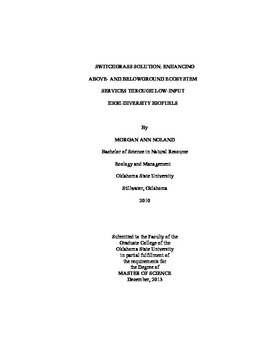| dc.description.abstract | It has been suggested that native prairie species such as switchgrass (Panicum virgatum) can provide a sustainable, low-input biofuel feedstock, while at the same time sequestering large amounts of soil carbon. Perhaps the most sustainable approach in producing carbon-negative bioenergy utilizes mixed-species perennial ecosystems. Previous studies on restored prairie communities indicate that long-term yields can be greater with higher plant diversity than with low diversity communities or monocultures. In addition, diverse grassland plantings can provide habitat for beneficial invertebrates and wildlife. We tested our hypothesis that low-input cultivation utilizing intra- and inter-specific diversity reduces fertilizer input and nutrient leaching while providing above- and belowground ecosystem services such as wildlife habitat, aggregate stability, and increased soil carbon. Specifically, our study assessed arbuscular mycorrhizal (AM) hyphal abundance, soil carbon, aggregate stability, and above- and belowground biomass production in established plots at Argonne National Laboratory, Batavia, Illinois. Our study included monocultures of three different switchgrass cultivars, inter-cropping of these three cultivars (intra-specific diversity), and combinations of switchgrass and native prairie species (inter-specific diversity). Annual productivity of extra-radical AM hyphae was assessed using hyphal in-growth bags. Phospholipid fatty acid analyses determined total soil microbial community composition and total AM fungal biomass. Our data indicate aboveground biomass production of the switchgrass cultivar cave-in-rock, was significantly greater than southlow, big bluestem/switchgrass mix, or the diverse prairie mix. Soil from the prairie mix had significantly greater aggregate stability than all other treatments, except switchgrass mix or kanlow monocultures. However, no differences were found among extra-radical hyphal production, total microbial biomass, total AM fungal biomass, or belowground biomass. Overall, our study indicates that intra- or inter-specific feedstock production can decrease fertilizer inputs while improving aboveground ecosystem services, with no loss in belowground services. | |
